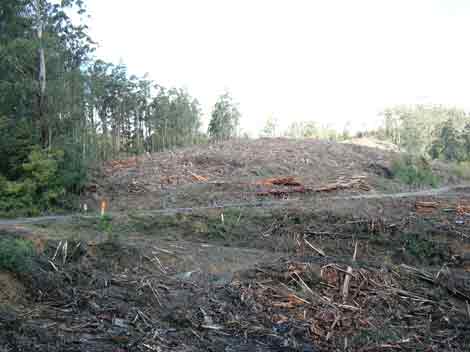

Conservation groups, Friends of the Gippsland Bush (FoGB) and Friends of the Earth (FoE) today announced that it was an urgent necessity for the Victorian State Government and Hancock Victorian Plantations (HVP) to resolve the Strzelecki forest controversy.
Hancock, trading in Gippsland as Grand Ridge Plantations Pty Ltd (GRP), announced last month that a 2 year moratorium on logging of areas identified in the Strzelecki Ranges Biodiversity Study (Biosis Research November 2001), as the Cores and Links had been lifted. "The company recently announced its intention to log almost 80 hectares of the cores and links in 2004/5. This could mean the opening of the logging floodgates in these and other high conservation value forest areas" said FoE spokesperson Anthony Amis.
Spokesperson for FoGB Susie Zent said "The local community and supporters have been battling conservation/biodiversity issues for many years. We urge Hancock and the State Government to work out a strategy in which the Cores and Links proposal is upheld and native vegetation in the Strzelecki and Gippsland regions is granted permanent protection".
Hancock currently control the rights to log about 32,500 hectares of natural forest and about 88,000 hectares of plantations throughout the Strzelecki Ranges and Gippsland region. HVP has agreed not to harvest in most areas containing natural forests, however conservationists fear that changes in management and future sale of its land base may mean termination of this current arrangement. "These areas need permanent long term protection" said Ms Zent. "The company should also be looking at the option of covenants on its private and leasehold land. This would provide the protection for the land that is required. We need an immediate resolution of this issue prior to GRP logging in these vital conservation areas" Ms Zent added.
"The State Government has consistently refused to honour its 1999 election promise 'to fully protect all conservation areas in the Strzeleckis'. Where is Steve Bracks and John Thwaites?" Mr Amis asked. "The Victorian Government far from delivering protection, chose to "offload" the Strzelecki Ranges State Forest to foreign interests in 1998. Former public land is now treated as private land and all logging is controlled through the Code of Forest Practice for Timber Production. Local Government is responsible for environmental compliance" Ms Zent added.
The company rightfully defends its political position to harvest some of these areas in accordance with government provision through the 1993 Victorian Plantations Corporation Act. However, at that time, the Government divested much of its Strzelecki public forests, before that forest had been assessed for its range of biodiversity assets. The State Forest portion of the company's estate was acquired by the Victorian Plantation Corporation prior to Government commitment to the Gippsland Regional Forest Agreement. This means that biodiversity values for the Strzelecki Ranges are excluded from protection under the (CAR*) reserve system. (As a general criterion, the CAR system requires that 15% of the pre-1750 distribution of each ecosystem should be protected. Where forest ecosystems are recognised as vulnerable, then at least 60% of their remaining extent should be reserved).
Presently, only 2% of the Strzelecki Ranges are protected within reserves. The Strzelecki Bioregion is unique to Victoria. Among other valuable biodiversity assets, it provides habitat for Victoria's only known colony of endemic koalas.
"Hancock and its subsidiary GRP, is the first company in Australia to receive the prestigious Forest Stewardship Council (FSC) conditional certification. There have been a lot of critics on both sides of the debate who have wanted to shoot this process down" said Mr Amis. "We are at a critical point, where not only could we see vital forest areas logged, but we could see the success or failure of FSC in Australia. If FSC fails to deliver sustainable ecological, social and economic outcomes for logging activities in Victoria, then its critics will broadcast its failings far and wide. Conversely, if the process works in the Gippsland Region, it could well be adopted throughout Australia as a way to move the forest debate forward in a responsible and mature manner" said Ms Zent.
"The ball is in Hancock's court" said Ms Zent. "They will receive very positive publicity if they move in the direction of long term protection of their native forest areas, including areas of high conservation value".
"If the protection isn't granted, international publicity for HVP's parent company, US based John Hancock Financial Services will be negative" said Mr Amis. He added, "A decision to log the cores and links will have wide scale implications for the company, and it will demonstrate that this company is not willing to deliver sustainable management of its estate, which is the underlying principle of the Forest Stewardship Council Certification process".
*CAR means Comprehensive Adequate and Representative Reserve System.
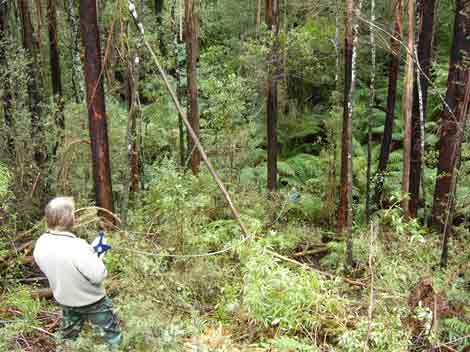
September 2004: Strzelecki Ranges North Face (Parish of Jumbuk - Crown Leasehold): Morwell River East Branch Rainforest off Lawless Track. Hancock have logged within 15 metres of cool temperate rainforest at this site. The person holding the tape in the gully is standing next to a Myrtle Beech tree. Rainforest of regional significance occurring in State Forest is granted at least 40 metre buffers. Yet Hancock at this site has granted 25 metre less than what is warranted in State Forests. This has occurred despite Hancock being granted FSC certification.

September 2004: Strzelecki Ranges North Face (Parish of Jumbuk - Crown Leasehold): Morwell River East Branch Rainforest off Lawless Track. Logging has occurred within 2 metres of young Myrtle Beech trees.
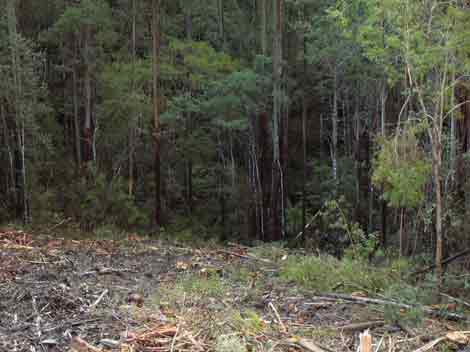
September 2004: Strzelecki Ranges North Face (Parish of Jumbuk - Crown Leasehold): Morwell River East Branch Rainforest off Lawless Track. Photo showing coupe boundary. Note that trees have fallen into rainforest area. These trees were knocked over by tree fall. Cool Temperate Rainforest requires buffers of at least two tree lengths to protect against tree fall, which can wound Myrtle Beech trees, leading to Beech trees being infected with the disease Myrtle Wilt.
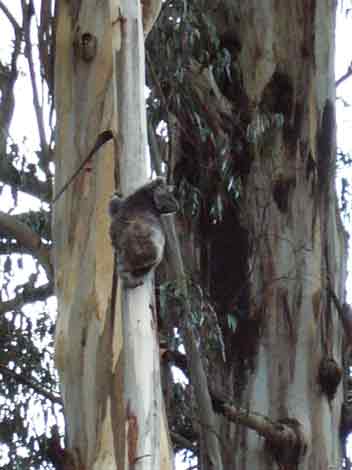
September 2004: Strzelecki Ranges North Face: Jeeralang Creek East Branch, just north of Taylors Road. Strzelecki Koala scampering for cover. Hancock have recently logged a coupe consisting of Mountain Grey Gum, Messmate, Bluegum and Mountain Ash. This coupe is prime koala habitat. Almost 4 years ago Hancock and the Australian Koala Foundation (AKF) signed a Memorandum of Understanding to obtain scientifically credible data on koala populations, critical habitat and future habitat needs. The Community is still waiting for the results of this report. Meanwhile Hancock continue to clearfell Koala habitat. Where oh where is the AKF and what happened to the MoU?
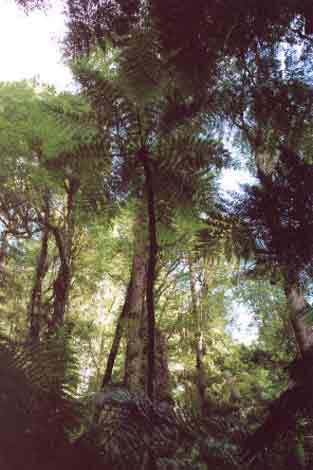
September 2004: Strzelecki Ranges South Face: Hancock staff has recently found a stand of cool temperate rainforest within their land holdings in the Parish of Bulga (Allotment 13) in the Tarra River Catchment. Most rainforest within this catchment is protected by the Tarra Bulga National Park. This stand of rainforest is of exceptional quality and lies outside the National Park boundary, just west of Bulga Park Road, almost 2 km south of Balook. The rainforest lies between 'plantation's established on land leased from the Victorian State Government in 1961. Rainforest buffers are rumoured to be of only 40 metres.
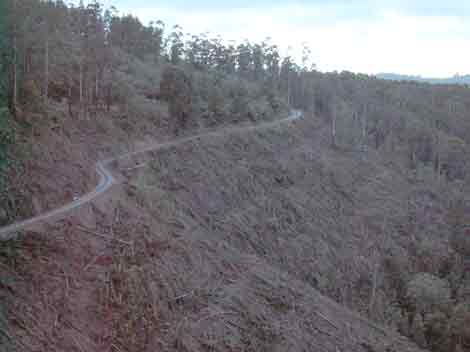
September 2004: Strzelecki Ranges North Face. Probably Parish of Callignee. Cable logging of hardwoods off Taylors Road in the Traralgon Creek catchment. This sets a very bad precedent, where further cable logging of hardwoods may eventuate. Taylors Road (a public road) has been closed for two months to allow this cable logging to occur.
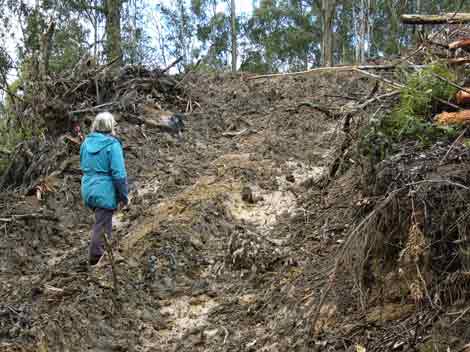
September 2004: Strzelecki Ranges North Face: Morwell River East Branch - Lawless Track. Poor access tracks contributing to sediment loads entering local waterways.

September 2004: Strzelecki Ranges North Face: Morwell River East Branch - Lawless Track. Head of gully very recently logged by Hancock, most likely located in the College Creek cores and links area.
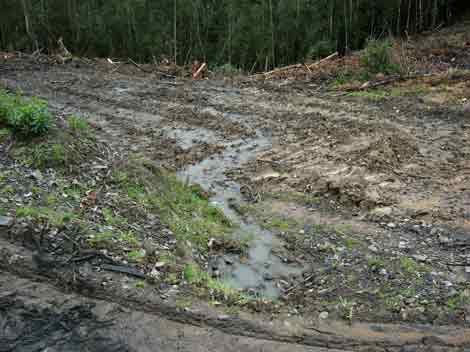
September 2004: Strzelecki Ranges North Face: Morwell River East Branch - Lawless Track. Drain outlet allowing flo of water across Lawless Track - Inappropriate drainage in breach of the Code of Forest Practice.
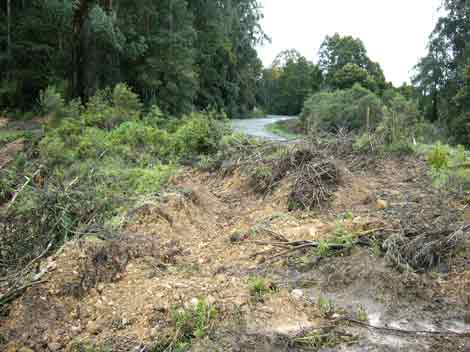
September 2004: Strzelecki Ranges North Face: Morwell River East Branch - Lawless Track. Recent bulldozer activity at head of gully, just off Midland Highway.
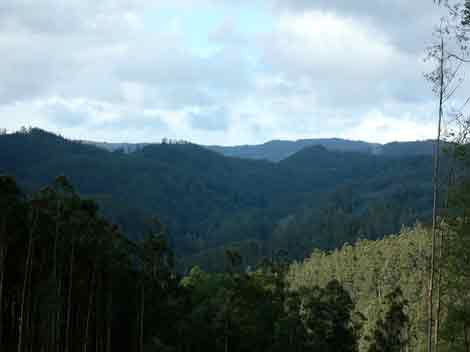
September 2004: Strzelecki Ranges north face - View looking east into Middle Creek Catchment from Link Letters Road in Parish of Jumbuk. Much of Middle Creek will be logged over the next years, with indigenous Mountain Ash being replanted with non-indigenous Shining Gum. Much of this catchment was established with trees by Australian Paper Manufactuers and the Victorian State Government in the 1960's and 1970's.
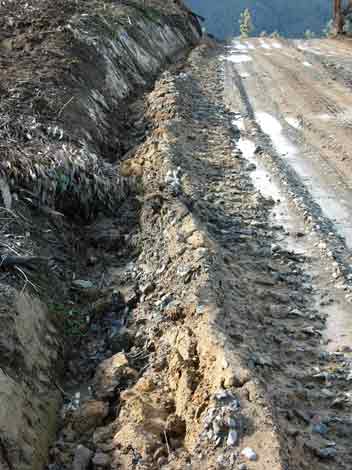
September 2004: Strzelecki RangesPoor drainage and road formation on Link Letters Road in the Middle Creek Catchment (Parish of Jumbuk).
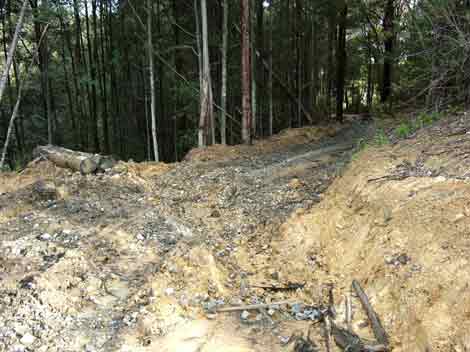
September 2004: Strzelecki Ranges - Jeeralang Creek East Branch - very poor roading just off Taylors Road. Parish of Jeeralang.
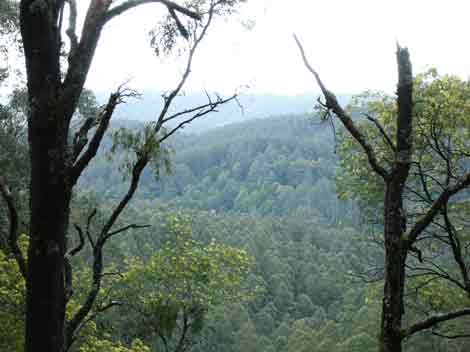
September 2004: Strzelecki Ranges - Morwell River catchment looking north east into Cool Temperate Rainforest off Grey Gum Track. Hancock want to log these areas soon.
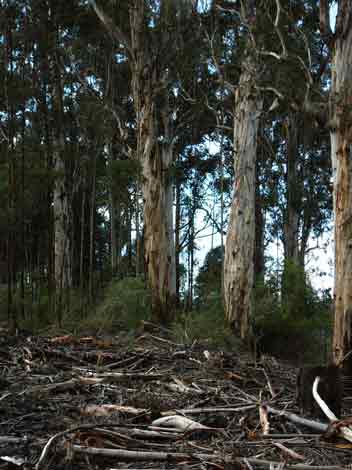
September 2004: Strzelecki Ranges - Jeeralang Creek East Branch - Old growth retained by Hancock just off Taylors Road. Parish of Jeeralang. Prime koala habitat.
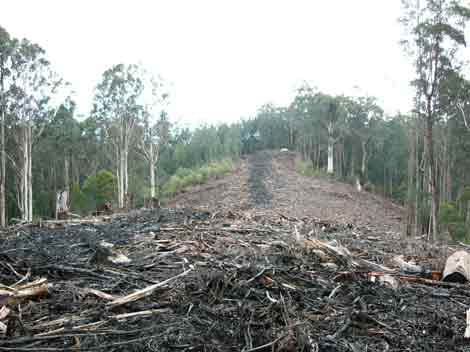
September 2004: Strzelecki Ranges - Jeeralang Creek East Branch - Logging coupe just off Taylors Road. Parish of Jeeralang. Prime koala habitat clearfelled, although Hancock appear not to have logged old growth trees.
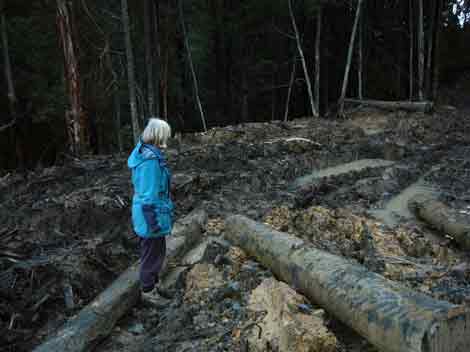
September 2004: Strzelecki Ranges - Jeeralang Creek East Branch - appalling roading and log dump located just off Taylors Road. Parish of Jeeralang. Obvious signs of Hancock working in wet weather.
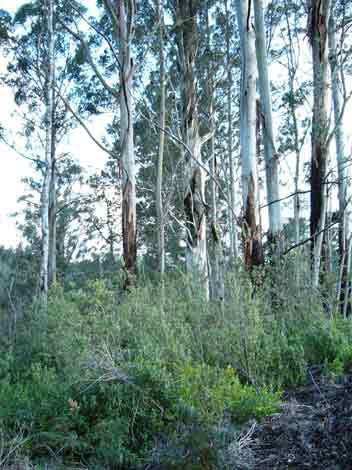
September 2004: Strzelecki Ranges - Jeeralang Creek East Branch. Retained native vegetation off Track 16.
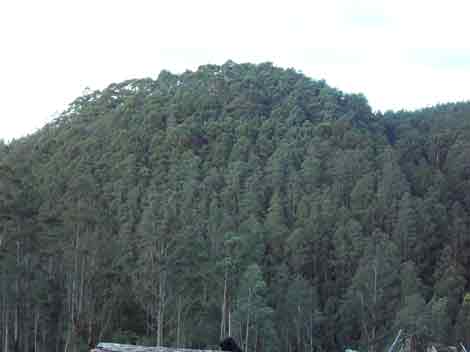
September 2004: Strzelecki Ranges - Probably allotment 11 of D Parish of Jeeralang. Native vegetation owned by Hancock in the Jeeralang Creek East Branch catchment. Ex private land previously owned by Australian Paper Plantations.
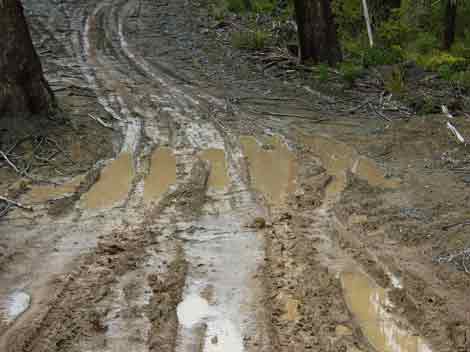
September 2004 - Strzelecki Ranges south face: Appalling roading and drainage on Minotti's Road in the Albert River Catchment.
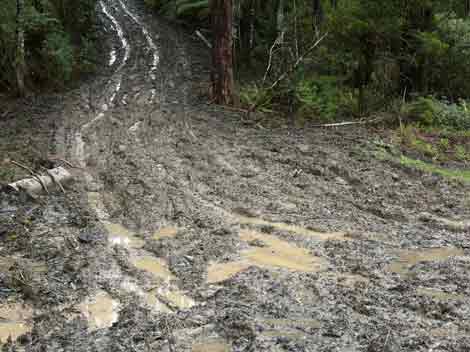
September 2004 - Strzelecki Ranges: Appalling roading and drainage on Snakes Back Track in the Morwell River Catchment. This exact spot was known to be habitat for the endangered Strzelecki Burrowing Crayfish.

September 2004: Morwell River East Branch. Probably allotment 51D Parish of Binginwarri on land leased to the Crown since 1926. This photo shows the scale of the clearfelling.
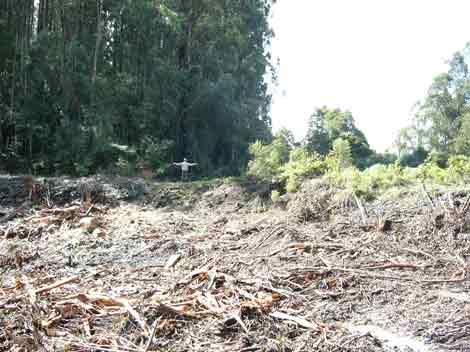
September 2004: Strzelecki Ranges North Face: Morwell River East Branch - Lawless Track. Head of gully very recently logged by Hancock, most likely located in the College Creek cores and links area, just off Midland Highway.
A Senate committee has recommended governments put a brake on forest plantations. The report called for joint venture research to study environmental benefits, especially the impact of plantations on water quality and quantity.
The recommendations demand basic changes to the Plantations for Australia: The 2020 Vision initiative, a partnership between federal and state governments and the plantation timber growing and processing industry, launched in 1997.
The overarching principle of the Plantations 2020 Vision strategy is to enhance regional wealth creation and international competitiveness through a sustainable increase in Australia’s plantation resources, based on a notional target of trebling the area of commercial tree crops by 2020.
"The committee therefore recommends that the revised 2020 Vision be amended by deleting all references to trebling the acreage by 2020 or plantation acreage of three million hectares," the report said.
"This should be replaced with the target of increasing the acreage of plantation forests at a sustainable and economic level."
The report also recommended the federal government commission an assessment of how the plantation prospectus industry relates to the 2020 Vision, including an evaluation of prospectus assumptions against likely returns.
The Australian Democrats and the Greens immediately called for a judicial inquiry into Tasmanian forests, which contain 22 per cent of Australia’s hardwood plantations, with Greens leader Bob Brown saying a royal commission should be considered.
Inquiry chairman and Democrats Senator Aden Ridgeway said the extensive inquiry report reflected a need for urgent and substantial changes to the way Tasmania’s forests and plantations were managed. "The Democrats are concerned that issues surrounding implementation of environmental standards and laws, and the use of water in plantation forestry, need immediate attention from both the federal and state governments," he said in a statement.
"Over and above these recommendations, the Democrats say a judicial inquiry into Tasmanian forestry practices and governance is essential. "We have also called for appropriate assessment of forestry activities under federal environment laws."
Senator Brown said it was time the plantation industry stood on its own without sudsidisation through massive tax concessions. He said malpractice in the industry and the loss of tourist jobs and potential investment and wealth in Tasmania had led to political parties to call for an inquiry.
"The Greens believe this should be a royal commission. The evidence warrants a royal commission," he told reporters. "What the majority have said is that, if they can’t get an independent inquiry, with open books, supported by federal and state governments, then they believe also that there should be more drastic measures and powers given to an independent inquiry with the indication that it should be set up at federal level.
Senate aims to cut back trees target
Melbourne Age 4/9/04 by Philip Hopkins
Billions of dollars of investment in Australia's plantation industry is under a cloud after a Senate committee yesterday recommended curbs on the sector.
The Senate's rural and regional affairs and transport references committee called on the Federal Government to scrap the Vision 2020 aim of trebling the area of plantations to 3 million hectares by 2020.
"This should be replaced with a target of increasing the acreage of plantations forests at a sustainable and economic level," said the committee in its report, Australian Forest Plantations.
The committee recommended that the Government commission an independent asessment of how the plantation prospectus industry relates to Vision 2020. This should include an evaluation of prospectus assumptions against returns likely to be achieved.
The committee's 17 recommendations also included:
*The plantation sector should research plantations' environmental benefits in relation to water availability, salinity and water quality, and plantations in low rainfall areas.
*The Commonwealth should urgently fund a water audit of the mainland and Tasmania to assess the impact of plantations on water quantity and quality.
*The Government should review the application of the mandatory renewable energy target legislation as it applies to the plantation woody crop industry.
The executive director of the National Association of Forest Industries, Kate Carnell, said she was disappointed with the recommendation to scrap the 3 million hectare target. "If the industry is to have a future, it must have a growth strategy. I do not know what a 'vision' is without a target," she said.
Ms Carnell said the report was convoluted, as if the committee did not agree on how to put it together. It also flew in the face of the decision by the federal and all state governments earlier this year to reaffirm and relaunch Vision 2020.
"All the governments agreed to have the target," she said. Ms Carnell said most people accepted that the growth of plantations was fundamental to ease the pressure on native forests. "Many people would like to think that growth in the timber industry will come from plantations," she said. "You can't do it if you don't have plantation growth."
Since the inception of Vision 2020 in 1997, more than 500,000 hectares of new plantations have been set up. Australian has now 1.66 million hectares of plantations - 988,233 hectares of softwood, mainly radiata pine, and 675,967 hectares of hardwood, predominantly blue gum.
Since 1997, the Federal Government said the scheme had generated investment of $1.5 billion in establishing plantations and more than $1 billion in new capital for sawmilling, paper manufacturing and wood-based panel industries.
Based on these trends, the establishment of another 1.5 million hectares of trees to meet the Vision 2020 target would require spending of up to $5 billion in new plantations alone. The Senate committee's emphasis on plantations' water use follows similar concerns in the Victorian Government's white paper earlier this year.